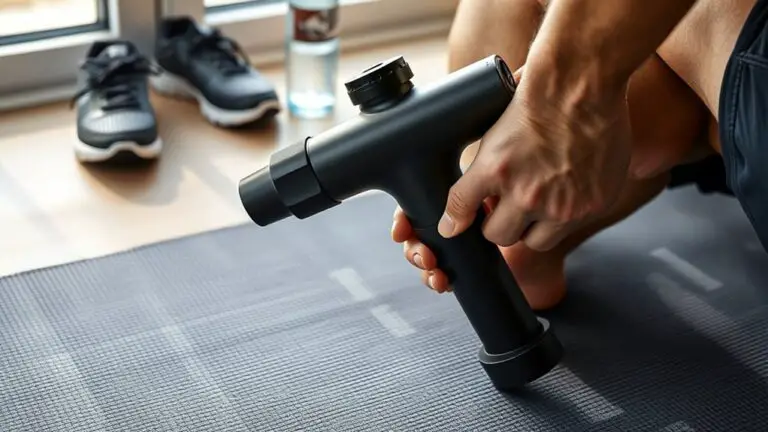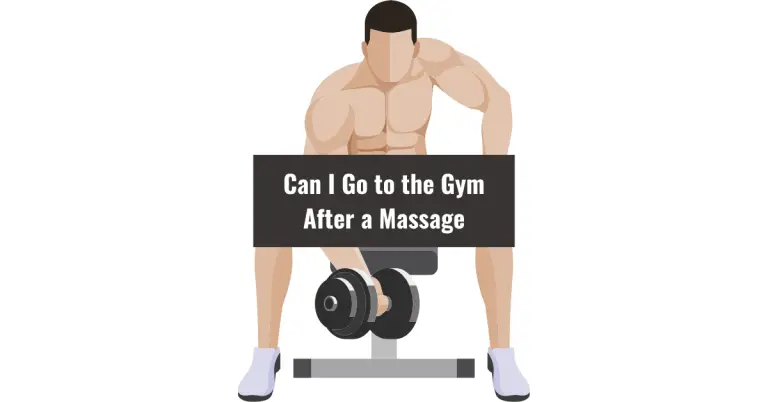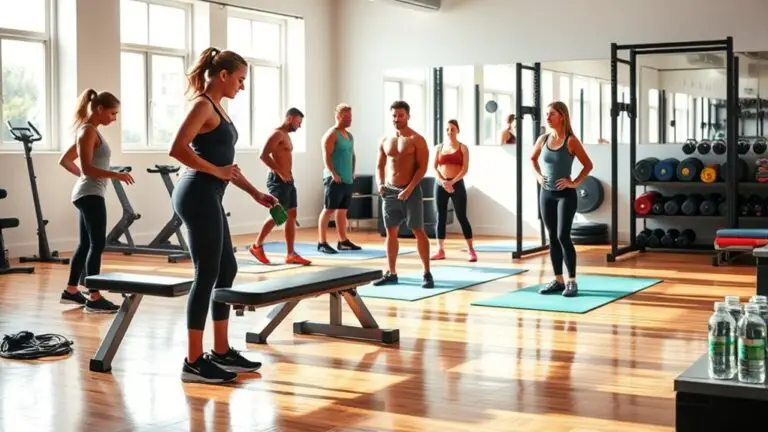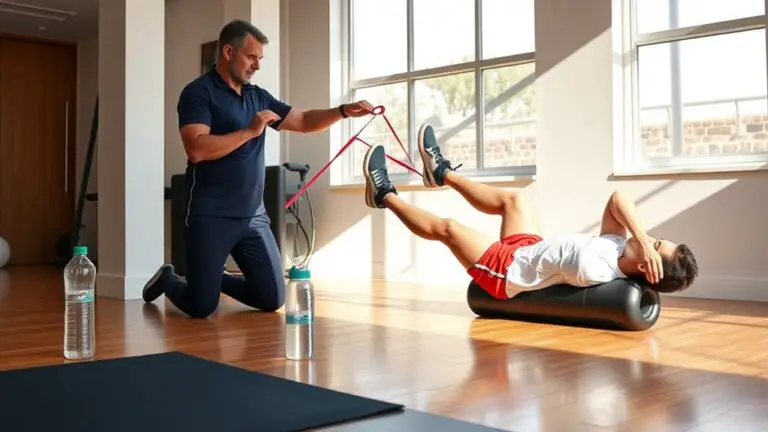How to Deal With Muscle Soreness After Gym Workouts
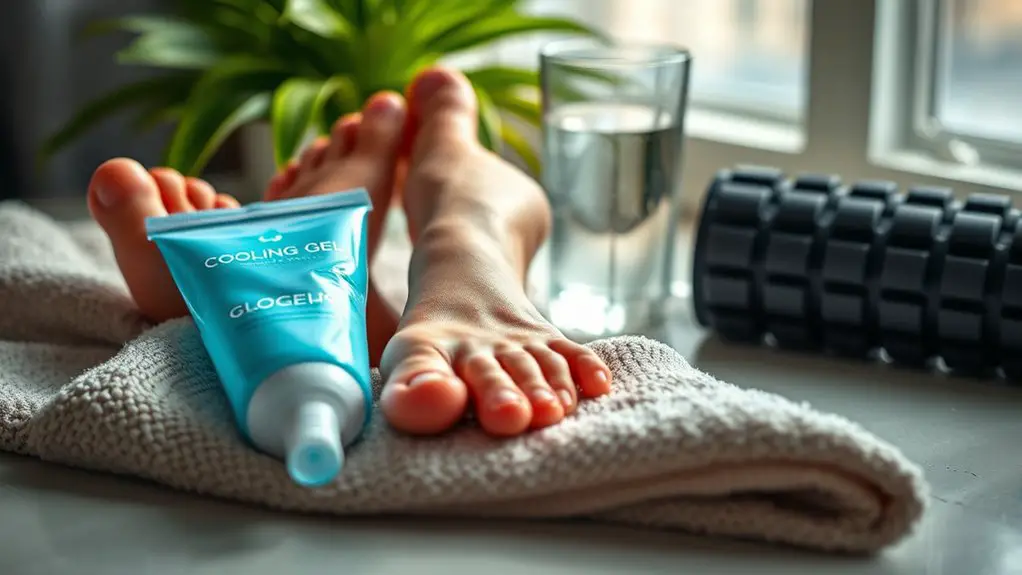
Muscle soreness after workouts, known as DOMS, is normal and shows your muscles are adapting. To manage it, warm up before exercising and stay hydrated. Post-workout, try foam rolling, light stretching, and active recovery. Don’t forget to refuel with protein and healthy carbs to aid in recovery. However, if soreness lasts more than a few days or worsens, you may need professional advice. Discover more strategies to ease soreness and boost your workout recovery.
Understanding Muscle Soreness: What You Need to Know

When you push your body in the gym, it’s common to experience muscle soreness afterward, which can leave you wondering about its causes. This soreness, often referred to as delayed onset muscle soreness (DOMS), typically sets in 24 to 48 hours post-workout. It’s your body’s natural response to the stress of exercise, particularly after trying new movements or increasing intensity.
During this recovery period, your muscles engage in repair processes, which can lead to feelings of stiffness and discomfort. While it might feel concerning, DOMS is generally a sign that your muscles are adapting and strengthening. However, it’s essential to listen to your body. If the pain feels excessive or lasts longer than a few days, consider consulting a healthcare professional. Remember, prioritizing safety and recovery will help you build strength effectively without overdoing it.
Pre-Workout Strategies to Prevent Soreness
To minimize muscle soreness, it’s essential to implement effective pre-workout strategies that prepare your body for exercise. Here are some tips to help you get started:
Implementing effective pre-workout strategies is key to minimizing muscle soreness and preparing your body for exercise.
- Dynamic Warm-Ups: Engage in movements that mimic your workout. This increases blood flow and flexibility, reducing injury risk.
- Hydrate: Drink plenty of water before your session. Proper hydration supports muscle function and can help alleviate soreness.
- Gradual Progression: Don’t jump into intense workouts right away. Gradually increase workout intensity and duration to allow your body to adapt.
- Nutrition: Fuel your body with a balanced meal or snack before exercising. Consuming protein and carbs can provide energy and support muscle recovery.
Effective Post-Workout Recovery Techniques

Although you might feel tempted to skip recovery after an intense workout, effective post-workout techniques are essential for minimizing muscle soreness and promoting overall recovery. Two key methods include foam rolling and active recovery. Foam rolling can help release muscle tension and improve blood flow, while active recovery keeps your body moving at a low intensity, aiding in muscle repair. It’s also crucial to be aware that lower back pain can arise from high-impact activities like skipping rope if proper precautions are not taken.
Here’s a quick look at these techniques:
| Technique | Purpose | Tips |
|---|---|---|
| Foam Rolling | Releases muscle tension | Roll slowly, focus on sore areas |
| Active Recovery | Promotes blood circulation | Engage in light activities like walking or cycling |
| Stretching | Improves flexibility and relaxation | Hold stretches for 20-30 seconds |
Implementing these techniques will not only enhance your recovery but also prepare you for your next workout. Don’t underestimate the power of a proper recovery routine!
Nutrition Tips to Aid Muscle Recovery
Proper nutrition plays an essential role in muscle recovery, especially after intense workouts. By focusing on the right nutrients, you can help your body heal and rebuild stronger. Here are some nutrition tips to aid in your recovery:
- Prioritize Protein Timing: Aim to consume protein within 30 to 60 minutes post-workout. This helps kickstart muscle repair.
- Stay Hydrated: Hydration is vital. Water helps transport nutrients to your muscles and flush out toxins.
- Include Healthy Carbs: Pair your protein with healthy carbohydrates, like whole grains or fruits, to replenish glycogen stores.
- Embrace Antioxidants: Foods rich in antioxidants, such as berries and leafy greens, can reduce inflammation and support recovery.
When to Seek Professional Help for Severe Soreness

How can you tell when muscle soreness crosses the line from normal discomfort to something more serious? It’s important to recognize the signs of injury. If your soreness lasts longer than a few days, worsens instead of improves, or is accompanied by swelling, bruising, or sharp pain, it’s time to worry. Additionally, if you can’t move the affected area or experience numbness, seek professional help immediately.
Listening to your body is essential. If you notice persistent soreness that doesn’t respond to rest, ice, or over-the-counter pain relievers, don’t hesitate to consult a healthcare professional. They can help rule out serious injuries like strains or tears. Remember, it’s always better to err on the side of caution. Taking action early can prevent further complications and guarantee a safer return to your fitness routine. Prioritize your health and don’t ignore the warning signs.
Frequently Asked Questions
Can Muscle Soreness Affect My Workout Performance?
They say, “No pain, no gain,” but muscle soreness can definitely affect your workout performance. If you’re feeling sore, it might hinder your workout intensity and lead to improper form, risking injury. Prioritizing muscle recovery is essential; it allows your body to heal and strengthen. Listen to your body—rest when needed, or choose lighter workouts to stay safe while still moving toward your fitness goals. Balance is key to long-term success!
Are There Specific Stretches to Alleviate Muscle Soreness?
Yes, specific stretches can help alleviate muscle soreness. Incorporating static stretches, like holding a hamstring stretch for 20-30 seconds, can promote flexibility and relaxation. Dynamic stretches, such as leg swings or arm circles, can also be beneficial, especially before workouts to warm up the muscles. Just remember to listen to your body; if a stretch feels painful, ease off to prevent injury and enhance your recovery process.
How Long Does Muscle Soreness Typically Last?
They say, “No pain, no gain,” but muscle soreness can be tricky. Typically, you’ll find that delayed onset muscle soreness (DOMS) peaks around 24 to 72 hours after your workout. It’s important to listen to your body and use recovery techniques like gentle stretching, hydration, and rest. Taking care of yourself guarantees you’re safe and ready for your next session, rather than pushing through pain that could lead to injury.
Can I Still Exercise With Muscle Soreness?
Yes, you can still exercise with muscle soreness, but it’s best to focus on active recovery. Gentle exercises, like walking or stretching, can help ease the discomfort without overexerting yourself. Listen to your body; if the pain feels sharp or intense, it’s a sign to rest. Engaging in lighter activities can promote blood flow and speed up recovery, keeping you safe and reducing the risk of injury while you heal.
Does Hydration Impact Muscle Soreness Levels?
Isn’t it amazing how something as simple as water can influence how your muscles feel? Yes, hydration does impact muscle soreness levels. When you stay well-hydrated, you’re supporting your body’s recovery strategies and helping to flush out toxins. Incorporating effective hydration techniques, like drinking water before, during, and after workouts, can greatly reduce soreness. So, make sure you’re drinking enough—your muscles will thank you, and you’ll feel more comfortable during your recovery!


